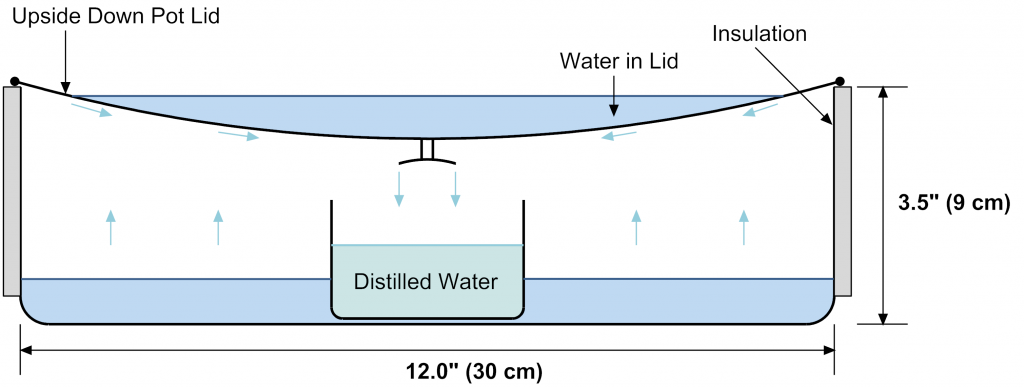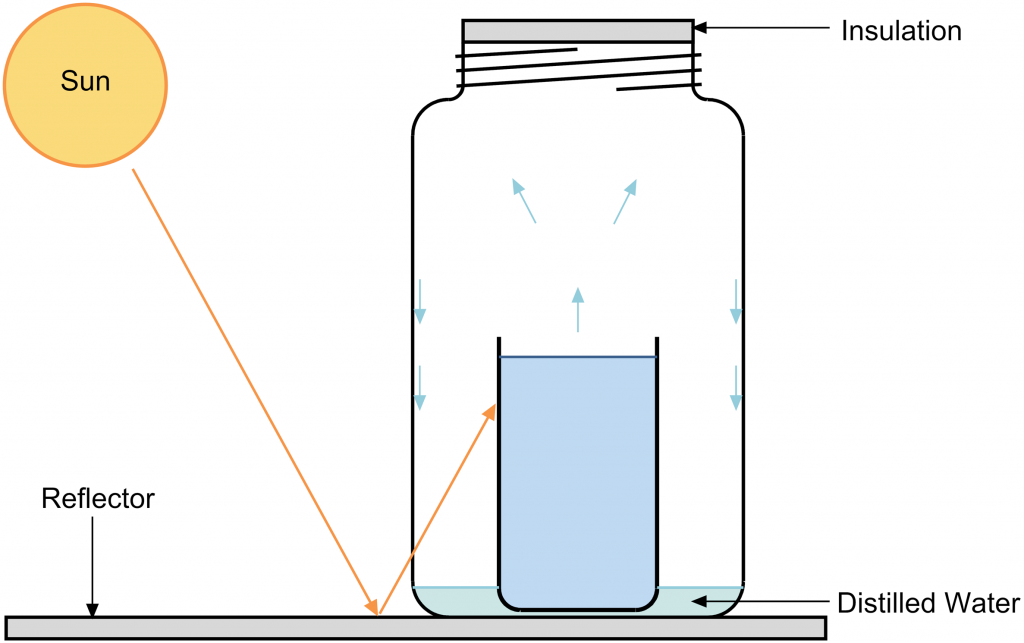Producing Distilled Water for Batteries
If a wet cell battery is not filled with distilled water, its life will be substantially reduced. In developing countries, it is often difficult to obtain distilled water. We recently investigated a number of methods distilling the small quantity of water needed for batteries. These included solar and fuel-based systems, as well as using waste heat from the condenser on our refrigerators. We eliminated using waste heat from the refrigerator’s cooling system because of the cost of modifying the refrigerator and the low rate of production.
Solar Distillation
The equipment needed for both the solar and fuel based methods is essentially the same, see Figure 1 below. For the solar application, we used a large diameter, relatively shallow pot with a glass cover. The cover was inverted so water condensed on the inside of the cover, ran toward the center of the pot and dripped down into a small cup. Water was added on top of the inverted lid to lower the temperature of the condensing surface and increase the efficiency of the still. The still will produce about 8 oz (200ml) per day.

Fig 1: Configuration for either solar or fuel based distillation. The pot cover would be glass for solar distillation.
If a glass covered pot is not available, a simple solar still can be made by placing a black open-topped can inside of a jar as seen in Figure 2. The can is filled with water. Water then evaporates and condenses inside the jar. The lid of the jar should be lightly insulated to prevent water from condensing on the lid and dripping into the open topped can. Sitting this jar on a reflector will increase distillation capacity. With a reflector, about 1 ounce (30 mL) could be produced per day. Production per day will decrease as the can empties. The can should be refilled when it is half empty.
Fuel Based Distillation
A pot could also be used as a still for a fuel-based system, however the lid of the pot need not be glass. The lid would be inverted and filled with water as with the solar application. Filling the lid more than doubles the efficiency of distillation. Using wood as a heat source, about 0.5 kg of wood will produce about 0.5 L of distilled water. If a load shedding charge controller was incorporated into a solar power system, excess electricity could be used to power an electrical hot plate. About 0.5 kWh would be required to distill 0.5 L of water. Production with a fuel-based system could be as high as 0.5 L per hour.
Perhaps the simplest method of distillation is using a conventional pot with an inverted lid. The lid need not be glass. Any fuel could be used to heat the pot and enough water to fill a battery could probably be generated in less than one hour. For the batteries of a vaccine storage system, the water consumption can be quite variable depending primarily on the voltage setting. However, it will almost always be less than 0.5 L per month.
Comments are closed.



If you live in a region where water is very contaminated, it would be wise to consider another
solution such as differing filters that you can fit around your home (shower filter, faucet filter or even a whole house filtration system which would ensure all of your water is as a good as
getting it direct from one of natures springs. This episode introduces three people who are embracing creative solutions to the looming
shortage of drinking water – be it desalinating the
ocean, catching rainwater or cleaning up our rivers.
As reflected acid with body, it is important that the
system remains stable.